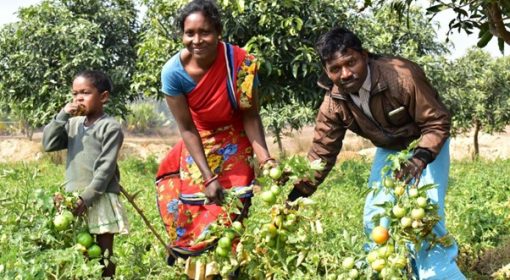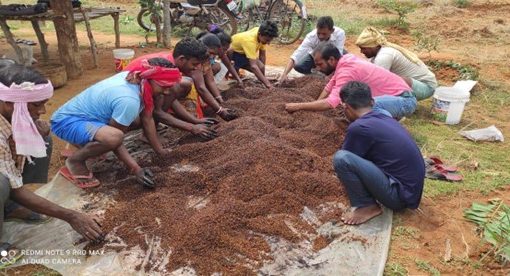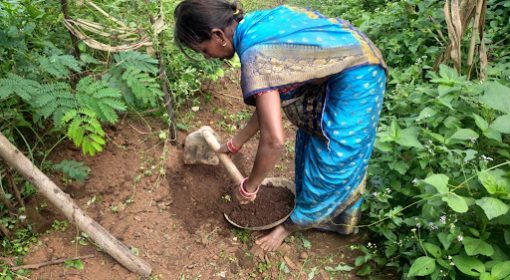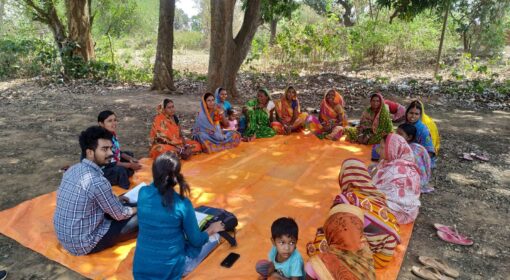By Anushree Mitra
In Jharkhand there is a common belief related to ploughing and tilling of the land that if a woman even touches the equipment, it will not rain.
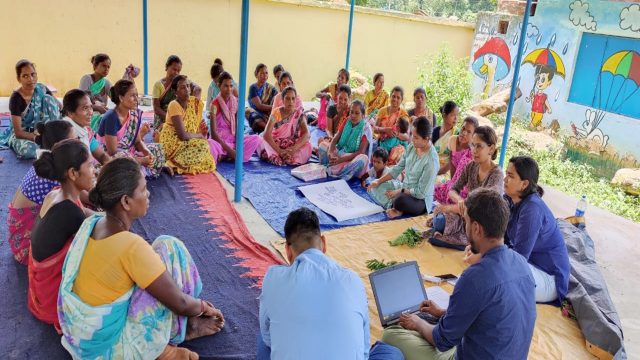
When we talk about farmers, often a common picture that comes in our minds is that of a male farmer. More often than not, the women are left out of the main picture; an alarming problem that we are dealing with. Women make up 48 percent of the Indian population but have not benefitted equally from India’s rapid economic growth.[i] During visits to tribal belts of Jharkhand and Madhya Pradesh, there was a major concern that kept coming up- women either hesitate to express their identities as farmers or are not aware of it. This reluctance stems from the age-old traditions and practices that hold a very strong place in their mindsets.
An interesting fact to note in this context is the division of labour. Not only are women here are strictly not allowed to till or plough the land, they are not allowed to even touch the equipment. According to them, only a man is supposed to perform this task. During focus-group discussions in Madhya Pradesh, one male farmer stated that since the land is very rocky and undulating, it is very difficult for a woman to till it. Nevertheless, on a daily basis a woman is engaged with unaccounted household chores like cooking, cleaning the house, washing dishes, clothes, preparing children for school, taking care of the livestock and grazing them. Apart from this they also perform most of the tasks in the fields such as sowing, harvesting, de-weeding, applying insecticides, pesticides, etc. Since the advent of Self-Help Groups (SHGs), they also involve themselves in meetings of the groups and work of local NGOs. They are already overburdened with work and despite such hard, accounted labour; the identity of women as farmers is still very obscure in their own minds and as well the society’s. Women in the context of agriculture are more labourers than decision makers. One of the reasons for this is the land ownership traditionally remaining with a man.
“God made night only so that women could sleep. Had he not made night for us, maybe we wouldn’t even have slept” – Woman farmer in Jharkhand
Women do not inherit the properties of their father or husband, only the male heir does. And if there isn’t a male heir, it gets passed onto some other male member in the family. Women even to this day are not the decision makers in agriculture. Although the situation is better than before but more often than not, a woman’s views and opinions are not considered.
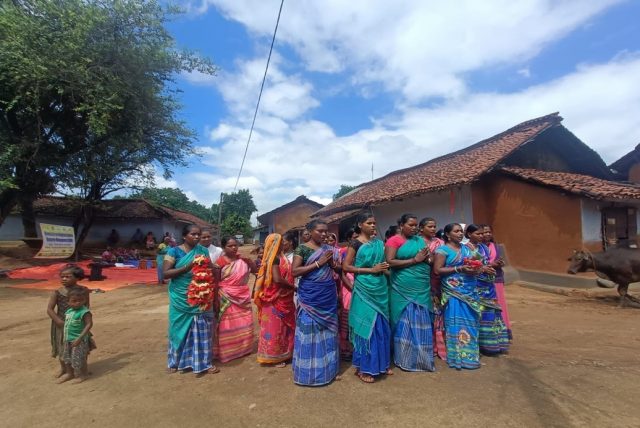
This is not just the case in Jharkhand and Madhya Pradesh states. Women of our society have been left out of the main picture for the longest time. Only in the recent past things have started changing and the recognition of the ‘other gender’ has been brought into the mainstream ideas. Local Civil Society Organizations (CSO), Community Based Development Organizations (CBDO), the Central as well as the State governments are promoting women farmers. Various schemes, interventions and projects planned around the central focus as women farmers, trainings, various incentives, handholding support and a lot more of such plans are being implemented.
In India the central as well as the state governments are providing huge benefits to women farmers. If the land is in the woman’s name, the government is giving incentives like low registration costs, loans, etc. For example, the Central government has a scheme called MKSP which recognizes the identity of “Mahila” (women) as “Kisan” (farmers) and strives to build the capacity of women in the domain of agro-ecologically sustainable practices. It has a clear vision to reach out to the poorest of poor households and expand the portfolio of activities currently handled by the Mahila Kisan (women farmer). Like this, there are many benefits for women farmers such as support for Women Food Security Groups (FSGs), representation of women farmers in decision making bodies, provision of seed money /revolving fund, capacity building, skill development and support services, etc.
Despite these development, very little progress has been made in this aspect overall. One of the reasons is traditional and cultural values. When we asked a group of male farmers in Jharkhand’s Godda district what their idea of women as farmers was, interestingly most of the men there agreed that women are also farmers. Some even acknowledged that women do most of the work related to their fields, yet none of them promoted ownership of land under women in their family. When asked why, a lot of them stated ‘if the woman abandons us, our land will also go with her.’ One male farmer above the age of 60 in the group said that ‘…we can never transfer the ownership of the land to the women. Only when the women will walk behind us, will they walk with us.’
Hurdles such as these are expected to come our way but we shall not stop. As we can already see, the interventions of Self-Help Groups, Micro Finance Institutions; effect of higher literacy rate, trainings in gender sensitization and bringing abuses under the purview of the law have been nothing short of a revolution in its own way for these women. Although this is still a long-drawn battle, hope is infinite.
When we interacted with various stakeholders like women farmers, male farmers, government officials, local governance functionaries, various other CSOs, something very interesting to observe was how each and all stakeholders think about the issues related to regenerative agriculture, women’s identity as farmers, government systems in the country, etc. Women farmers have started acknowledging themselves as farmers, especially after the intervention of FPO (Farmer’s Producer Organization). But there is still some reluctance to accept this due to the traditional belief that only men are farmers. But here and there we can see small acts of rebellion like, a particular woman who had fought with her husband and sold their produce alone in the market without anyone’s help and sold it at a much better price (women do not have access to markets Another interesting aspect that came out of the FGDs was the attitude of the government functionaries towards the women, especially the ones who had a strong voice. On one hand, the government is on a mission to promote women farmers. On the other hand, some functionaries get angry at women who complain. When asked about issues regarding women, one can see a lot of blame game coming. While some officials say that the women don’t raise their voice; others blame the system and the ignorance of the government on the ground. Similarly in the case of local governance and functionaries, a lot of negligence and corruption has been found. They also blame the system and stated that no one ever listens to them. But in reality, a lot of times we have seen that they do not let the women come forward and voice their opinions.
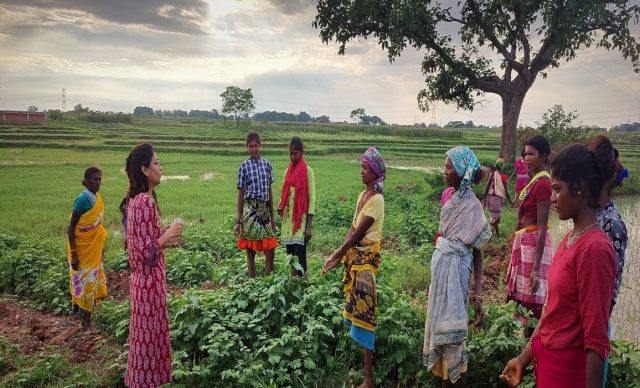
In the context of Jharkhand and Madhya Pradesh, women and their contribution to agriculture are undeniable. In the area of organic farming or regenerative agriculture, currently with the help of a local NGO, PRADAN, numerous women are making and selling organic inputs as well. Various trainings are going on to strengthen their capacities in agriculture, especially regenerative practices. Thus, from producing farm inputs, to selling, to applying them to the fields, to managing their households, families and fields— in every aspect we see the protagonist to be a woman. When properly analysed, we can see a lot of gaps, lacunas, discrepancies, corruption, and negligence in the systems. Right now, our focus should be more on analysing the systems enough to come up with interventions and plans which will not only impact at scale but also shall be sustainable. We should hope for a future where when people talk about farmers, they shall think of a woman as well. I’ll end this with a quote from a woman farmer in Jharkhand. This one shall stay with me for a long time.
“You study the books and learn agriculture. We practice it on land and learn agriculture.”
[i] https://www.worldbank.org/en/news/feature/2019/03/08/working-for-women-in-india
